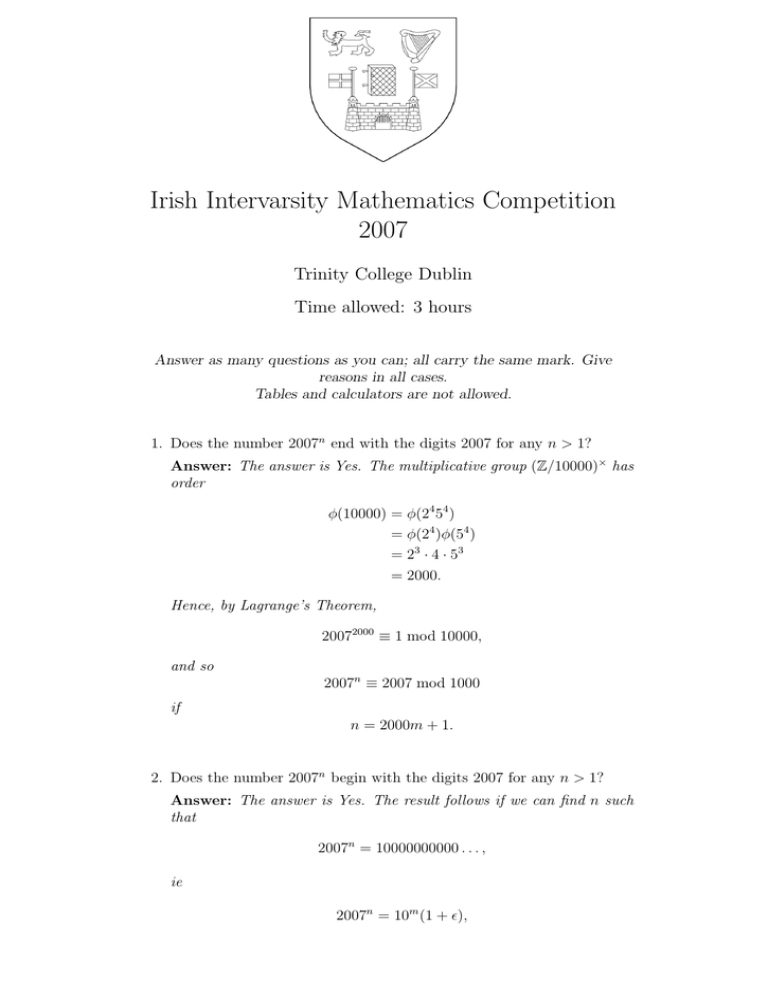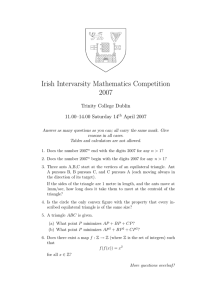Irish Intervarsity Mathematics Competition 2007 Trinity College Dublin Time allowed: 3 hours
advertisement

Irish Intervarsity Mathematics Competition
2007
Trinity College Dublin
Time allowed: 3 hours
Answer as many questions as you can; all carry the same mark. Give
reasons in all cases.
Tables and calculators are not allowed.
1. Does the number 2007n end with the digits 2007 for any n > 1?
Answer: The answer is Yes. The multiplicative group (Z/10000)× has
order
φ(10000) = φ(24 54 )
= φ(24 )φ(54 )
= 23 · 4 · 53
= 2000.
Hence, by Lagrange’s Theorem,
20072000 ≡ 1 mod 10000,
and so
2007n ≡ 2007 mod 1000
if
n = 2000m + 1.
2. Does the number 2007n begin with the digits 2007 for any n > 1?
Answer: The answer is Yes. The result follows if we can find n such
that
2007n = 10000000000 . . . ,
ie
2007n = 10m (1 + ),
where 0 < < 0.00000000001; for then
2007n+1 = 2007 . . . ,
Taking logarithms to base 10, and setting α = log10 2007,
nα = m + log10 (1 + ),
which will hold if
0 ≤ [nα] ≤ ,
We can find such an n for any real number α. (This is Kronecker’s
Theorem.) For if we consider the remainders [nα], two must differ by
less than (by the Pigeon Hole Principle), say
0 ≤ [rα] − [sα] ≤ ,
and so
0 ≤ [nα] ≤ ,
for n = r − s.
3. Three ants A,B,C start at the vertices of an equilateral triangle. Ant
A pursues B, B pursues C, and C pursues A (each moving always in
the direction of its target).
If the sides of the triangle are 1 metre in length, and the ants move at
1mm/sec, how long does it take them to meet at the centroid of the
triangle?
Answer: The 3 ants will always lie at the vertices of an equilateral
triangle A(t)B(t)C(t), with the same centroid O.
The angle
∠OA(t)B(t) = π/6.
Hence the component of the velocity of ant A towards O is
√
v = 1 · cos(π/6) = 3/2.
Initially
√
2
3
AO = ·
· 1000.
3 2
Hence the time taken for the ants to reach O is
T =
2000
seconds.
3
4. Is the circle the only convex figure with the property that every inscribed equilateral triangle is of the same size?
Answer:
2
5. A triangle ABC is given.
(a) What point P minimizes AP + BP + CP ?
(b) What point P minimizes AP 2 + BP 2 + CP 2 ?
Answer:
6. Does there exist a map f : Z → Z (where Z is the set of integers) such
that
f (f (x)) = x2
for all x ∈ Z?
Answer: The answer is Yes.
Note that if we set
s(x) = x2
then
f 2 = s =⇒ sf = f s,
ie
f (x2 ) = f (x)2 .
In particular,
f (0)2 = f (0), f (1)2 = f (1).
It follows that either
f (0) = 0, f (1) = 1 or f (0) = 1, f (1) = 0.
More generally, if
f (a) = b
then
f (b) = a2 , f (a2 ) = b2 , f (b2 ) = a3 , . . . .
Let us divide the integers n > 1 into chains
C(r) = {r, r2 , r4 , r8 , . . . }.
Thus N \ {0, 1} is partitioned into
C(2), C(3), C(5), C(6), . . . ,
with a chain C(r) starting with each non-square r.
Divide the chains into pairs (C(2), C(3)), (C(5), C(6)), . . . Suppose
C(r), C(s) is one pair. Then we can set
f (ri ) = si , f (si ) = ri+1 .
We can extend the definition to Z by setting
f (−n) = f (n).
3
7. Show that every rational number x ∈ (0, 1) can be represented uniquely
in the form
a1 a2
ak
x=
+
+ ... + ,
1!
2!
k!
where a1 , . . . , ak are integers with 0 ≤ ai < i for 1 ≤ i ≤ k.
Answer: Notice that a1 = 0, since 0 ≤ 11 < 1.
Let
a2 = [2x],
and let
x2 = 2x − a2 .
Then
0 ≤ a2 < 2,
and
0 ≤ x2 < 1.
Let
a3 = [3x2 ],
and let
x3 = 3x2 − a3 .
Then
0 ≤ a3 < 3,
and
0 ≤ x3 < 1.
Continuing in this way, the process will end if and when
xk+1 = 0.
It is easy to see that this will happen when
k!x ∈ N,
as must be true for some k.
8. What is the greatest number of parts into which the plane can be
divided by n straight lines?
Answer:
9. Three points A, B, C are chosen at random on the circumference of a
circle. What is the probability that the centre of the circle lies inside
ABC?
Answer: Suppose the angle subtended by AB at the centre is θ. Then
C must lie on an arc subtending the same angle at the centre. (In fact
4
C must lie in the reflection of the arc AB in the centre. The probability
of this is θ/2π. Thus the probability that the centre lies in ABC is
Z
1 π θ
p=
dθ
π 0 2π
π
1 θ2
= 2
2π
2 0
1
= .
4
10. A circular hole of diameter 1 is drilled through the centre of a sphere
of radius 1. What is the volume of the drilled sphere?
Answer: We calculate the volume removed. We can regard this as
made up of cylindrical shells of radius r and thickness dr, as r varies
from 0 to 1/2. The height of the cylindrical shell is h, where
x2 + h2 = 1,
ie
√
h=
1 − x2 ,
and its volume is
2πxh.
Hence the volume removed is
1/2
Z
V = 2π
√
x 1 − x2 dx.
0
Setting x = sin θ this gives
Z
π/3
V = 2π
sin θ cos θ cos θ dθ.
0
Now
2 sin θ cos2 θ = sin θ(1 − cos 2θ)
= sin θ − sin θ cos 2θ
1
= sin θ − (sin 3θ − sin θ)
2
1
= (3 sin θ − sin 3θ).
2
Hence
π
π/3
[−3 cos θ − cos 3θ/3]0
2
√
π
= (3 − 3 32 + 2/3)//
6
Hence the volume remaining is
V =
=
√
4π
π
V = (61 + 3 3).
−
18
5
√
π
(11 − 3 3).
18





![Math 131 Practice Exam 3 on [ -1, 4].](http://s2.studylib.net/store/data/010538103_1-a851ef52d08f89241a99ddd9d94bbb2a-300x300.png)